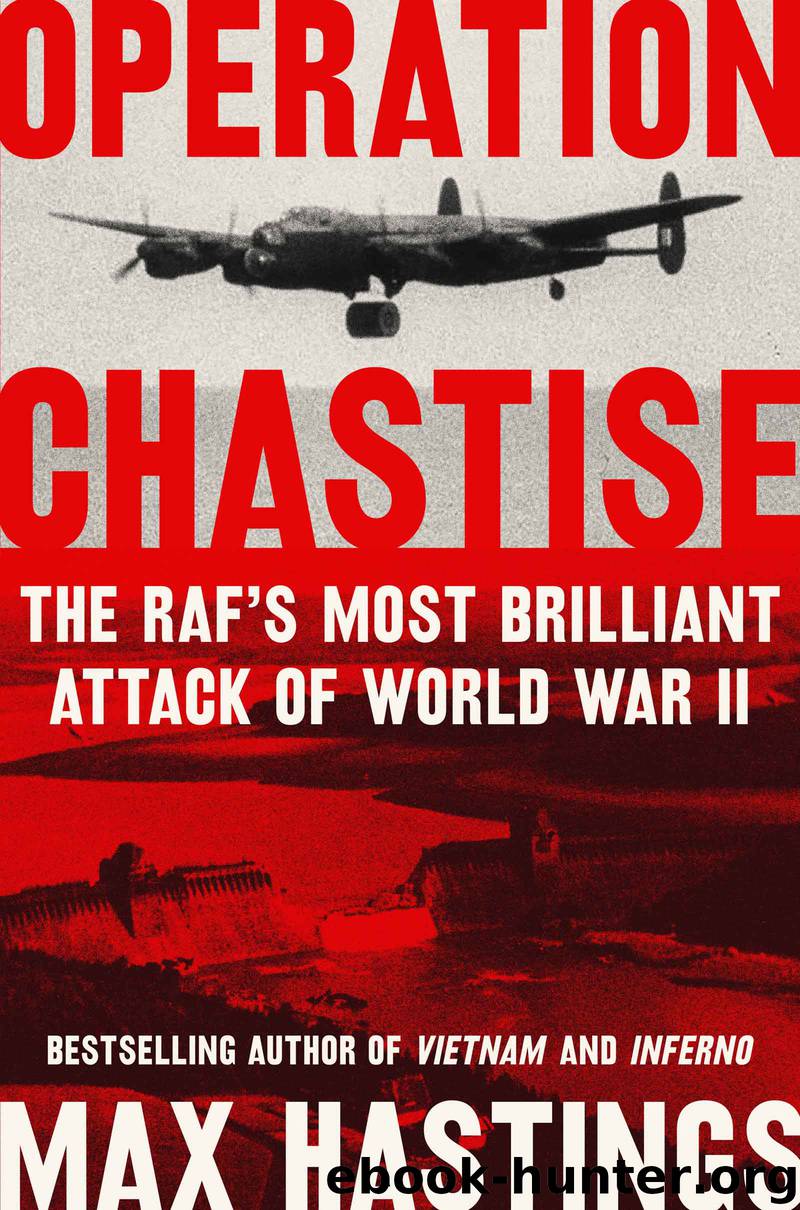Operation Chastise by Max Hastings

Author:Max Hastings
Language: eng
Format: epub
Publisher: HarperCollins
Published: 2019-12-12T16:00:00+00:00
2 Getting There
Gibson’s section crossed the Suffolk coast at Southwold at 2229, forty minutes after take-off. Its three Lancasters then flew onwards in a fashion few had ever experienced, so low that the rushing aircraft shapes were reflected on the sea beneath them. The accustomed pattern of night bomber operations, the received wisdom of their war, was that height conferred improved prospects of survival, so that all the way to Germany pilots clawed at the sky, welcoming every few extra feet of altitude. Yet now this squadron, for this one mission, was flying the entire route to the target below the five-hundred-foot threshold at which German radar must pick them up. Cochrane’s planners believed, undoubtedly correctly, that on a moonlit night which would be suicidal for Main Force bomber operations, only a low-level approach might spare Gibson and his squadron from slaughter by night-fighters. The acknowledged rule of the game was that once a fighter engaged a victim, unless an alert gunner cried a warning, precipitating a drastic ‘corkscrew’ descent, the bomber and its crew were probably dead meat. Only a minority of aircraft survived attack by a Ju88 or Bf110, and there could be no corkscrewing from an altitude of less than a hundred feet.
Yet while most of Goering’s night-fighters stayed on the ground until scrambled following a radar alert, ten thousand flak guns of all calibres were continuously manned. Concentrations of 88mm heavies, Flak 30 and Flak 38 automatic weapons were clustered in belts between the Dutch coast and the dams. The lighter guns had no need of radar to alert them – they could hear heavy bombers coming. And whereas USAAF B-17 Flying Fortresses were heavily armoured for daylight operations, British bombers relied on darkness for protection. The Lancaster was a superb aircraft, but the price of carrying its impressive bombload was that its airframe could withstand much less punishment than its American counterparts from cannon or machine-gun fire.
That May night was full of dilemmas for the attackers. The lower they flew, the better their chances. Yet below a hundred feet their Gee electronic navigation aid, normally reliable and unjammed on the North Sea crossing, became erratic because of the curvature of the earth. Accurate course monitoring was vital to avoid the flak. On 16 May, this depended upon the skills of individual navigators, and their diligence in monitoring winds over the North Sea by dropping flame floats. Some Chastise crews suffered severely for lack of Gee assistance, succumbing to unnoticed drift caused by unforecast wind.
Gibson’s three lead aircraft approached Holland at 2250. In G-George, Richard Trevor-Roper, who had stood behind the cockpit for part of the run across the North Sea, removed his Mae West and disappeared to the rear turret. While they were still over the water John Pulford momentarily flicked on the spotlights under the plane’s belly, to check their height. The beams seemed a distance from convergence, and the flight-engineer suggested dropping down a little. In the nose ‘Spam’ Spafford said, ‘There’s the
Download
This site does not store any files on its server. We only index and link to content provided by other sites. Please contact the content providers to delete copyright contents if any and email us, we'll remove relevant links or contents immediately.
| Automotive | Engineering |
| Transportation |
Whiskies Galore by Ian Buxton(41803)
Introduction to Aircraft Design (Cambridge Aerospace Series) by John P. Fielding(33046)
Small Unmanned Fixed-wing Aircraft Design by Andrew J. Keane Andras Sobester James P. Scanlan & András Sóbester & James P. Scanlan(32731)
Craft Beer for the Homebrewer by Michael Agnew(18123)
Turbulence by E. J. Noyes(7920)
The Complete Stick Figure Physics Tutorials by Allen Sarah(7291)
Kaplan MCAT General Chemistry Review by Kaplan(6851)
The Thirst by Nesbo Jo(6809)
Bad Blood by John Carreyrou(6519)
Modelling of Convective Heat and Mass Transfer in Rotating Flows by Igor V. Shevchuk(6377)
Learning SQL by Alan Beaulieu(6192)
Weapons of Math Destruction by Cathy O'Neil(6116)
Man-made Catastrophes and Risk Information Concealment by Dmitry Chernov & Didier Sornette(5900)
Digital Minimalism by Cal Newport;(5633)
Life 3.0: Being Human in the Age of Artificial Intelligence by Tegmark Max(5447)
iGen by Jean M. Twenge(5352)
Secrets of Antigravity Propulsion: Tesla, UFOs, and Classified Aerospace Technology by Ph.D. Paul A. Laviolette(5299)
Design of Trajectory Optimization Approach for Space Maneuver Vehicle Skip Entry Problems by Runqi Chai & Al Savvaris & Antonios Tsourdos & Senchun Chai(4996)
Electronic Devices & Circuits by Jacob Millman & Christos C. Halkias(4889)
